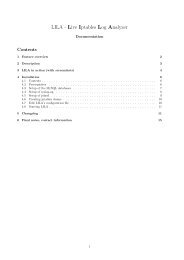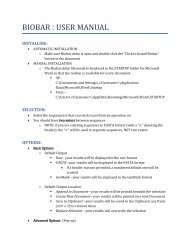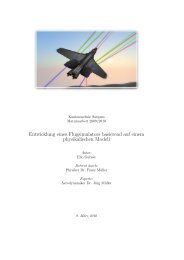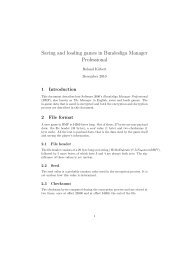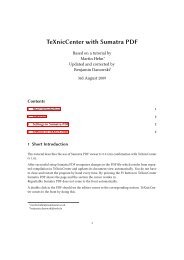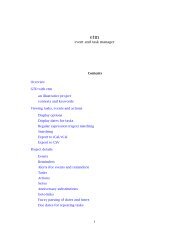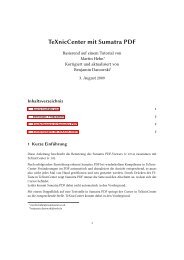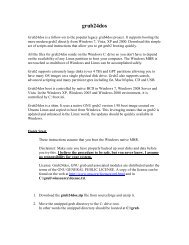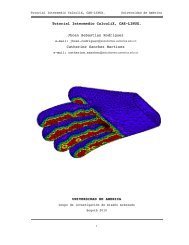Easy Java Websites (EJW)
Easy Java Websites (EJW)
Easy Java Websites (EJW)
You also want an ePaper? Increase the reach of your titles
YUMPU automatically turns print PDFs into web optimized ePapers that Google loves.
<strong>Easy</strong> <strong>Java</strong> <strong>Websites</strong> (<strong>EJW</strong>)<br />
Configuration<br />
An Extremely <strong>Easy</strong> To Use<br />
Web Application Development Framework<br />
for <strong>Java</strong><br />
Copyright © 2005 - Present, Easier<strong>Java</strong> All Rights Reserved.<br />
This Easier <strong>Java</strong> Persistence manual is a copyrighted work and is not transferable. If you received this manual<br />
somewhere other then Easier<strong>Java</strong>.com, please report it.<br />
Easier<strong>Java</strong> and <strong>EJW</strong> are trademarks or registered trademarks of Easier<strong>Java</strong>, Inc. in the U.S. and other countries.<br />
<strong>Java</strong> and all <strong>Java</strong>-based marks are trademarks or registered trademarks of Sun Microsystems, Inc. in the U.S. and<br />
other countries. All other marks are trademarks or registered trademarks of their respective holders in the U.S.<br />
and other countries.
EASY JAVA WEBSITES CONFIGURATION.........................................................................................................<br />
4<br />
...................................................................................................................................................................... 4<br />
Parameters............................................................................................................................................................<br />
6<br />
Security Roles........................................................................................................................................................<br />
6<br />
................................................................................................................................................................. 6<br />
Forward.................................................................................................................................................................<br />
7<br />
Forward References..............................................................................................................................................<br />
7<br />
..................................................................................................................................................................... 8<br />
Redirect.................................................................................................................................................................<br />
8<br />
Redirect References...............................................................................................................................................<br />
9<br />
............................................................................................................................................................................... 9<br />
Special Forward/Redirect Conditions.................................................................................................................<br />
10<br />
URL Referencing.................................................................................................................................................<br />
10<br />
....................................................................................................................................................... 11<br />
Validation............................................................................................................................................................<br />
11<br />
Validation References.........................................................................................................................................<br />
12<br />
................................................................................................................................................................... 13<br />
REQUESTS<br />
FORWARDING<br />
REDIRECTS<br />
URL<br />
DATA VALIDATION<br />
MESSAGES<br />
CONFIGURING THE <strong>EJW</strong> SERVLET<br />
SERVLET 3.X ANNOTATIONS<br />
SERVLET DEPLOYMENT DESCRIPTOR (WEB.XML)<br />
.................................................................................................................. 13<br />
........................................................................................................................................... 13<br />
.............................................................................................................. 14<br />
Servlet (required) ................................................................................................................................................ 15<br />
configFile (optional) ........................................................................................................................................... 15<br />
useDomainName (optional) ................................................................................................................................ 15<br />
validateXML (optional) ....................................................................................................................................... 16<br />
initDestroyHandler (optional) ............................................................................................................................ 16<br />
classPrefix (optional) .......................................................................................................................................... 17<br />
urlRewriting (optional) ....................................................................................................................................... 17<br />
Servlet Mapping (required) ................................................................................................................................. 17<br />
SPECIAL TOPICS<br />
.................................................................................................................................................... 18<br />
LOGGING.....................................................................................................................................................................<br />
18<br />
REST (RESTFUL WEB SERVICE) REQUESTS..................................................................................................................<br />
18<br />
AJAX REQUESTS........................................................................................................................................................<br />
20<br />
DEFAULT REQUEST.......................................................................................................................................................<br />
20<br />
ERROR HANDLING........................................................................................................................................................<br />
21<br />
SECURITY/USER AUTHENTICATION..................................................................................................................................<br />
21<br />
SECURE CONNECTIONS...................................................................................................................................................<br />
22<br />
URL REWRITING.........................................................................................................................................................<br />
23<br />
APPENDIX A – VALIDATION................................................................................................................................<br />
23<br />
................................................................................................................................................................... 24<br />
................................................................................................................................................. 24<br />
........................................................................................................................................................................ 24<br />
............................................................................................................................................................. 24<br />
........................................................................................................................................................................ 24<br />
.................................................................................................................................................................... 25<br />
...................................................................................................................................................................... 25<br />
................................................................................................................................................................. 25<br />
............................................................................................................................................... 25<br />
...................................................................................................................................................................... 25<br />
......................................................................................................................................... 25<br />
.............................................................................................................................. 26<br />
.................................................................................................................................................................. 26<br />
........................................................................................................................................................................... 26<br />
ENDSWITH<br />
ENDSWITHIGNORECASE<br />
ISBYTE<br />
ISCREDITCARD<br />
ISDATE<br />
ISDOUBLE<br />
ISEMAIL<br />
ISEQUALTO<br />
ISEQUALTOIGNORECASE<br />
ISFLOAT<br />
ISGREATEROREQUALTOMIN<br />
ISGREATEROREQUALTOMINLENGTH<br />
ISINRANGE<br />
ISINT
ISISBN<br />
.........................................................................................................................................................................<br />
26<br />
ISLESSOREQUALTOMAX<br />
..............................................................................................................................................<br />
26<br />
ISLESSOREQUALTOMAXLENGTH<br />
...................................................................................................................................<br />
26<br />
ISLONG<br />
.......................................................................................................................................................................<br />
27<br />
ISNOTEMPTYORNULL<br />
...................................................................................................................................................<br />
27<br />
ISEMPTYORNULL<br />
.........................................................................................................................................................<br />
27<br />
ISSHORT<br />
......................................................................................................................................................................<br />
27<br />
ISSUBSTRING<br />
................................................................................................................................................................<br />
27<br />
ISSUBSTRINGIGNORECASE<br />
..............................................................................................................................................<br />
27<br />
ISTRUEFALSE<br />
...............................................................................................................................................................<br />
27<br />
ISURL<br />
.........................................................................................................................................................................<br />
28<br />
ISYESNO<br />
.....................................................................................................................................................................<br />
28<br />
MATCHESREGEXP<br />
.........................................................................................................................................................<br />
28<br />
STARTSWITH<br />
................................................................................................................................................................<br />
28<br />
STARTSWITHIGNORECASE<br />
..............................................................................................................................................<br />
28<br />
APPENDIX B – <strong>EJW</strong> DTD<br />
........................................................................................................................................<br />
28
<strong>Easy</strong> <strong>Java</strong> <strong>Websites</strong> Configuration<br />
NOTE: With configuration based requests everything else is the same as<br />
configuration free requests (see configuration free documentation).<br />
<strong>EJW</strong> provides a completely optional, but simple, XML configuration mode which consists of:<br />
<br />
<br />
<br />
<br />
<br />
<br />
<br />
<br />
<br />
<br />
<br />
This mode provides the ability for class and method reuse, passing in static parameters, regular<br />
expression matching of URIs, soft coded URIs, and soft coded messages. <strong>EJW</strong> configuration<br />
even allows overriding configuration free and other configurations. The configuration mode also<br />
provides for XML defined security, forwarding, redirects and validation.<br />
Requests<br />
Requests allow you to associate a piece of <strong>Java</strong> executable code to a web request. All<br />
parameters, security roles, forwards, redirects, and validations are used in the context of a<br />
request, and a request can have any number of each.<br />
Syntax:<br />
<br />
Id The request Id is equal to the value returned by<br />
request.getRequestURI(), with all leading path<br />
information removed, leaving only the filename<br />
portion of the URI. The request Id must also be
unique within the document. For example:<br />
/webapp/p1/customer<br />
/webapp/p1/customer/customer.ejw<br />
would produce the following request Ids:<br />
customer<br />
customer.ejw<br />
This value is your request Id.<br />
match The match attribute overrides matching the request Id<br />
to the URI and will instead match the request URI to<br />
the match string. Can use characters that can’t be<br />
used in an XML Id. This attribute is optional and<br />
overrides matching the request Id.<br />
matchRegExp The matchRegExp attribute overrides both matching<br />
the request Id and the match string and will instead<br />
match the request URI to the regular expression<br />
string. Great flexibility in matching URIs and you<br />
can use wildcards the regex way(.*). This attribute is<br />
optional and overrides matching both the request Id<br />
and match.<br />
secureConnection If true, the request will only be processed over a<br />
secure (https) connection. This attribute is optional<br />
and the default is false.<br />
handlerClass The <strong>Java</strong> class instance to associate with the request.<br />
This class must extend RequestHandler. If this<br />
attribute is not defined, then there must be a forward<br />
with ‘key=”success”’ defined or a “home” url must<br />
be defined.<br />
handlerMethod The method name in the class that is to be called.<br />
The method defined in the class should have<br />
“validate” prepended for a validation method. But,<br />
“validate” shouldn't be included in the<br />
“handlerMethod” definition. During a web request,<br />
<strong>EJW</strong> will check the class for a method matching the<br />
name “validate[Method]()”, if found it will be called.<br />
If handlerMethod is not defined, the default name<br />
“request” will be used and the same process above<br />
will be used with validateRequest() being called first<br />
(if it exists), followed by request().
Parameters<br />
<br />
Parameters define information that can be passed to and accessed by your RequestHandler<br />
classes.<br />
name a key value associated with value<br />
value The data value of interest.<br />
Accessing parameter values within code is done with:<br />
ServerInterface.getRequestData().getParameter(“parameterName”);<br />
Security Roles<br />
This element is optional, but when defined, the request will be limited to authenticated users who<br />
have the defined role associated with them. There can be any number of security roles defined<br />
for a given request. Requests that don’t have any roles defined are not limited, and can be<br />
accessed by any authenticated or non-authenticated user. A user only has to be in one role to<br />
access the request.<br />
If a non-authenticated user or a user that does not possess the role tries to access a request limited<br />
by roles, <strong>EJW</strong> will throw an error and return the forwarding indicator “authenticationError”. If<br />
no forwarding is defined in the request for “authenticationError”, <strong>EJW</strong> will fall back to global<br />
“error” forwarding.<br />
Syntax:<br />
<br />
Forwarding<br />
role A valid security role associated with authenticated users.<br />
Request forwarding is central to web application flow control and goes hand-in-hand with your<br />
RequestHandler’s methods. The string values your RequestHandler methods return have to exist<br />
in your request forwarding as a forward or a forwardReference definition that points to a defined<br />
forward. A request can have any number of forwards and forward references defined.<br />
Note: urls, Forwards, and redirects contain the same information and can be used<br />
interchangeably when being referenced.
Forward<br />
Syntax:<br />
<br />
Forward References<br />
Id Id is a valid XML Id string that is unique within the<br />
document.<br />
Key Key is usually a value returned by your RequestHandler<br />
methods (see Special Forwarding Conditions) and is<br />
defined by you for you. Your RequestHandler validation<br />
method should return “success”, “validationError”, or<br />
another value that is defined in your request forwarding.<br />
Your RequestHandler processing method can return<br />
anything that is defined in your request forwarding or<br />
“noForwarding” if the request has been satisfied, and no<br />
return page is required.<br />
Protocol This attribute is optional and useful for forcing a switch<br />
between protocols (i.e., http to https, https to http) in<br />
relative URLs.<br />
Protocol is only useful when referencing forwarding URLs<br />
in web authoring via “${ejwUrl.id}” for menus, form<br />
actions, and other URL-linking purposes.<br />
url Any valid complete or context relative URL.<br />
rewriteUrl True or False. Use URL rewriting for cookie limited<br />
browsers. Defaults to true.<br />
“forwardReference” references a defined forward. You can use “forwardReference” inside any<br />
number of requests to use a forward over and over. The key can be different with any of the<br />
forward references.<br />
Syntax:<br />
<br />
idRef idRef is a valid XML Id string that references a forward<br />
definition that is defined within the document.<br />
Key Key is usually a value returned by your RequestHandler<br />
methods (see Special Forwarding Conditions) and is defined<br />
by you for you. Your RequestHandler validation method<br />
should return “success”, “validationError”, or another value
Redirects<br />
that is defined in your request forwarding.<br />
Your RequestHandler processing method can return<br />
anything that is defined in your request forwarding or<br />
“noForwarding” if the request has been satisfied, and no<br />
return page is required.<br />
Redirects are useful for redirecting a browser to a different URL. You can use this feature to<br />
send a user to a secure connection when coming in over an insecure connection. Or use it simply<br />
to redirect to a different page.<br />
Note: urls, Forwards, and redirects contain the same information and can be used<br />
interchangeably when being referenced.<br />
Redirect<br />
Syntax:<br />
<br />
id Id is a valid XML Id string that is unique within the<br />
document.<br />
Key Key is usually a value returned by your RequestHandler<br />
methods (see Special Forwarding Conditions) and is<br />
defined by you for you. Your RequestHandler validation<br />
method should return “success”, “validationError”, or<br />
another value that is defined in your request forwarding.<br />
Your RequestHandler processing method can return<br />
anything that is defined in your request forwarding or<br />
“noForwarding” if the request has been satisfied, and no<br />
return page is required.<br />
This attribute is not needed with globally scoped forwards.<br />
Protocol This attribute is optional and useful for forcing a switch<br />
between protocols (i.e. http to https, https to http) in<br />
relative URLs.<br />
url Any valid complete or context relative URL.<br />
rewriteUrl True or False. Uses URL rewriting for cookie limited<br />
browsers. Defaults to true.
Redirect References<br />
“redirectReference” references a defined redirect. You can use “redirectReference” inside any<br />
number of requests to use a redirect over and over. The key can be different with any of the<br />
redirect references.<br />
Syntax:<br />
url<br />
<br />
idRef idRef is a valid XML Id string that references a redirect<br />
definition that is defined within the document.<br />
Key Key is usually a value returned by your RequestHandler<br />
methods (see Special Forwarding Conditions) and is defined<br />
by you for you. Your RequestHandler validation method<br />
should return “success”, “validationError”, or another value<br />
that is defined in your request forwarding.<br />
Your RequestHandler processing method can return<br />
anything that is defined in your request forwarding or<br />
“noForwarding” if the request has been satisfied, and no<br />
return page is required.<br />
url is the global version of forward and redirect and is the only URL information that can be<br />
defined outside a request. Like forwards and redirects it can be referenced by either<br />
forwardReference or redirectReference from within a request. url is provided as a more intuitive<br />
version of the forward statement to coincide with the ${ejwUrl} for page authoring.<br />
Syntax:<br />
<br />
Id Id is a valid XML Id string that is unique within the<br />
document.<br />
Protocol This attribute is optional and useful for forcing a switch<br />
between protocols (i.e. http to https, https to http) in<br />
relative URLs.<br />
Protocol is only useful when referencing forwarding URLs<br />
in web authoring via “${ejwUrl.id}” for menus, form<br />
actions, and other URL-linking purposes.<br />
Protocol is the value inserted before the beginning of the
Special Forward/Redirect Conditions<br />
URL and can be any valid URL type (i.e. http, https, etc.).<br />
url Any valid complete or context relative URL.<br />
rewriteUrl True or False. Use URL rewriting for cookie limited<br />
browsers. Defaults to true.<br />
Certain situations call for special forward/redirect handling. The following lists the special cases<br />
defined for <strong>EJW</strong> that your RequestHandler methods can return, and with the exception of<br />
“noForwarding”, your forward/redirect definitions can catch these special conditions by defining<br />
the following as forward keys for a request.<br />
noForwarding Request processing stops. Useful for handling web events that don’t<br />
need a page returned.<br />
authenticationError This forward key is returned when there is no user logged in or the<br />
user does not have permission for the request.<br />
notSecureError This forward key is returned when a request requires a secure<br />
connection but the connection is not secure.<br />
validationError A validation error was encountered.<br />
login In the case of an authentication error, if the authenticationError key is<br />
not defined, <strong>EJW</strong> will automatically forward to a login page if one is<br />
defined. Otherwise, <strong>EJW</strong> will forward to the error page.<br />
error Any errors that may occur will be forwarded to the defined error page.<br />
home The web applications home page.<br />
URL Referencing<br />
URLs can have references to other urls, forwards, and redirects by using:<br />
“${ejwUrl/id}”<br />
which will include the URL, as is, into the URL doing the referencing. For example:<br />
<br />
with:<br />
<br />
will result in a URL that equals “/mainView.jsp?c=intro”.
There can be any number of references in a URL, and URLs can reference a URL which also has<br />
a URL reference. However, a URL reference must have ‘${‘, followed by a ‘forward/redirect<br />
id’, followed by ‘}’.<br />
Data Validation<br />
Data validation can be handled from two places. One is from your <strong>Java</strong> code. The other is<br />
automatic validation from validation definitions in your XML configuration file.<br />
You can access the validation handler from your <strong>Java</strong> code via<br />
ServerInterface.getValidationHandler(), which returns a reference to a ValidationHandler that<br />
contains methods corresponding to all the methods available with XML-based validation.<br />
Using “validation” and “validationReference”, you can define any number of validations for<br />
your incoming data.<br />
A data element can have any number of validations, as well. You can first check for<br />
“isNotEmptyOrNull” and then check if it is a properly formatted email with “isEmail”.<br />
NOTE: Empty data is not considered an error by default, so you must check<br />
specifically for an empty or null value using “isNotEmptyOrNull”, as<br />
validations do not consider it an error if the value is empty, null, or not found.<br />
Validation<br />
Validations are defined globally and then referenced in requests via “validationReference”. A<br />
request can have any number of validations defined for the incoming data parameters.<br />
Syntax:<br />
<br />
id Id is a valid XML Id string that is unique within the<br />
document.<br />
parameterName The form/query string parameter name, etc., as returned<br />
by ServletRequest.getParameter(parameterName).<br />
type Defines the type of data being validated, and is one of:<br />
endsWith<br />
endsWithIgnoreCase<br />
isByte<br />
isCreditCard<br />
isDate
Validation References<br />
isDouble<br />
isEmail<br />
isEqualTo<br />
isEqualToIgnoreCase<br />
isFloat<br />
isGreaterOrEqualToMin<br />
isGreaterOrEqualToMinLength<br />
isInRange<br />
isInt<br />
isIsbn<br />
isLessOrEqualToMax<br />
isLessOrEqualToMaxLength<br />
isLong<br />
isNotEmptyOrNull<br />
isShort<br />
isSubstring<br />
isSubstringIgnoreCase<br />
isTrueFalse<br />
isUrl<br />
isYesNo<br />
matchesRegExp<br />
startsWith<br />
startsWithIgnoreCase<br />
See Appendix A for details on validation types.<br />
arguments Some validations, such as comparison validations,<br />
require an argument, such as the string to compare<br />
with. This attribute is usually not needed, but depends<br />
on the needs of the validation.<br />
errorMessage The message you want to display to the user.<br />
“validationReference” references a defined validation. You can set up a global validation, and<br />
then use “validationReference” inside any number of requests to use the validation over and<br />
over. The parameter name can be different with any of the validation references.<br />
Syntax:<br />
<br />
idRef idRef is a valid XML Id string that references a<br />
validation definition that is defined elsewhere within<br />
the document.<br />
parameterName The form/query string parameter name, etc., as returned
Messages<br />
by ServletRequest.getParameter(parameterName).<br />
Messaging is useful for allowing “soft” coded messages that can be changed anytime without<br />
going into the web page source. You can set up any number of messages and access them via:<br />
${ejwMessage.id}<br />
in your web page. Messaging does not currently support “java.util.Locale” directly. However,<br />
JSTL/JSP does, and it’s not hard to set up in Velocity.<br />
Syntax:<br />
<br />
Configuring the <strong>EJW</strong> Servlet<br />
id Id is a valid XML Id string that is unique within the<br />
document.<br />
value The message to display to the user via “${ejwMessage.id}”<br />
in the view.<br />
<strong>EJW</strong> supports both servlet 3.x annotations, as well as, typical deployment discriptor (web.xml)<br />
definitions.<br />
Servlet 3.x Annotations<br />
NOTE: As you well know, annotations are equal to hard coding, so proceed<br />
with that knowledge.<br />
By implementing the following:<br />
@WebServlet(urlPatterns={"/"},<br />
initParams={<br />
@WebInitParam(name="param-name", value="param-value")<br />
})<br />
public class SimpleController extends RequestServlet { }
you can create your own custom controller (<strong>EJW</strong> handles controller functionality automatically)<br />
to take advantage of Servlet 3.x annotations. This allows you to do away with the web.xml<br />
deployment descriptor. You can use any of the Servlet 3.x annotations.<br />
You can also use the @MultipartConfig annotation for file uploads. However, <strong>EJW</strong> also<br />
supports file uploads and both the Servlet 3.x implementation and <strong>EJW</strong> use Apache's commons<br />
file upload package. The difference is <strong>EJW</strong> handles multipart form data requests dynamically,<br />
where as, the servlet spec 3.x requires the request to be multi-part form data.<br />
Servlet Deployment Descriptor (web.xml)<br />
The following Tomcat example is based on the standard Servlet specification 2.4, which you can<br />
download from Sun Microsystems’ <strong>Java</strong> website at http://java.sun.com.<br />
You can define the servlet with “RequestServlet” or any other name you like, which you will<br />
map requests to a little later. The servlet supports several initialization parameters, which are<br />
defined below.<br />
<br />
RequestServlet<br />
ejw.RequestServlet<br />
<br />
configFile<br />
/WEB-INF/webapp.xml<br />
<br />
<br />
useDomainName<br />
your_host_name<br />
<br />
<br />
validateXml<br />
true<br />
<br />
<br />
initDestroyHandler<br />
business.AppUtils<br />
<br />
<br />
classPrefix<br />
webapp<br />
<br />
<br />
urlRewriting<br />
true<br />
<br />
RequestServlet<br />
*.ejw<br />
<br />
Servlet (required)<br />
The servlet class is always “ejw.RequestServlet” and is defined with:<br />
<br />
RequestServlet<br />
ejw.RequestServlet<br />
<br />
where “servlet-name” is anything you like, and will be referenced later in the servlet-mapping<br />
definition.<br />
configFile (optional)<br />
The <strong>EJW</strong> configuration file is an XML file (defined later) used to define requests, forwarding,<br />
validation, etc. <strong>EJW</strong> uses ServletContext.getResource() to locate the file, so the file can be<br />
located anywhere that ServletContext.getResource() can find a resource. The best place for it is<br />
probably in “/WEB-INF”.<br />
Example:<br />
<br />
configFile<br />
/WEB-INF/webapp.xml<br />
<br />
useDomainName (optional)<br />
Used with page authoring and URL building via ${forwardingUrlBuilder.forwardId}, which<br />
allows you to force multiple domains into one default domain. This could be useful in situations<br />
like security certificates, where you can only have a single certificate defined, but multiple<br />
domains are mapped to a single IP. The default is for ${forwardingUrlBuilder.forwardId} to use<br />
the domain returned by ServletRequest.getServerName(), which is the domain the user typed in<br />
the browser’s address bar.<br />
Example:
useDomainName<br />
www.softwaresensation.com<br />
<br />
validateXML (optional)<br />
By default, <strong>EJW</strong> does not use a validating parser while parsing the XML configuration. It is best<br />
to use this entry with “true” defined to make sure the configuration is conforming to the XML<br />
standard and to pick up any DTD-related errors that may be present.<br />
Example:<br />
<br />
validateXml<br />
true<br />
<br />
initDestroyHandler (optional)<br />
In the case where you have startup and/or cleanup needs with your web application, <strong>EJW</strong> allows<br />
you to define a class to handle servlet startup and shutdown events. This class is defined to <strong>EJW</strong><br />
with:<br />
<br />
initDestroyHandler<br />
java_class_without_extension<br />
<br />
The class must extend the class InitDestroyHandler:<br />
public class InitDestroyHandler<br />
{<br />
public void init(ServletContext context) throws Exception {}<br />
public void destroy(ServletContext context) throws Exception {}<br />
}<br />
The “init” method will be called with the servlets first use and the “destroy” method will be<br />
called when the servlet is shut down.<br />
Example:<br />
initDestroyHandler<br />
business.AppUtils<br />
<br />
classPrefix (optional)<br />
The class prefix is used for configuration free requests and is simply prepended to the URI. This<br />
provides a secure method for locating classes dynamically.<br />
Example:<br />
<br />
classPrefix<br />
webapp<br />
<br />
urlRewriting (optional)<br />
By default, <strong>EJW</strong> performs URL rewriting for ${ejwUrl.key}. If you do not want URL rewriting,<br />
you can turn it off with:<br />
<br />
urlRewriting<br />
false<br />
<br />
Servlet Mapping (required)<br />
Servlet mapping is part of the servlet specification 2.4, which you can download from Sun<br />
Microsystems’ <strong>Java</strong> website at http://java.sun.com. Servlet mapping goes hand-in-hand with the<br />
servlet definition above. You can define any number of mappings, and you can map any request<br />
pattern to the servlet.<br />
Example:<br />
<br />
RequestServlet<br />
/webapp/*<br />
<br />
Usual mappings are path-oriented mappings:<br />
/path/*
or extension-oriented mappings:<br />
*.ext<br />
If using path-oriented mappings, you will see all static content such as images, style sheets, html,<br />
etc., going through the servlet as well. So, we recommend extension mapping. Both will work,<br />
but path based will increase the work load on the servlet.<br />
Special Topics<br />
Logging<br />
NOTE: With logging set to DEBUG, you can see diagnostic information including<br />
details of the web requests.<br />
<strong>EJW</strong> uses slf4j (www.slf4j.org). Slf4j is a simple logger facade 4 <strong>Java</strong>. It supports the major<br />
logging frameworks such as log4j, <strong>Java</strong> logging, logback, commons logging, etc.<br />
slf4j (required):<br />
Download from: www.slf4j.org<br />
Must have slf4j-api.jar in your classpath.<br />
slf4j simple (defaults to info):<br />
Download from: www.slf4j.org<br />
Copy slf4j-api.jar and slf4j-simple.jar to your classpath.<br />
logback (defaults to debug):<br />
Download from: logback.qos.ch<br />
Copy slf4j-api.jar, logback-classic.jar and logback-core.jar to your classpath.<br />
log4j (requires configuration):<br />
Download from: http://logging.apache.org/log4j<br />
Copy slf4j-api.jar, slf4j-log4j.jar and log4j.jar to your classpath.<br />
REST (RESTful Web Service) Requests
NOTE: Regular <strong>EJW</strong> request handling can also be RESTful, as the server interface<br />
will provide any information required to figure out what type of request is<br />
made, as well as, the path arguments sent.<br />
RESTful requests are handled in a configuration free manner. The request is matched to a class:<br />
public class MyRestfulHandler extends RestfulHandler<br />
{<br />
public String get(ServerInterface serverInterface, String[] args) { ... }<br />
public String post(ServerInterface serverInterface, String[] args) { ... }<br />
...<br />
}<br />
with an exact match of what is defined in the servlet mapping (the servlet path):<br />
<br />
ejwRequestServlet<br />
/myRestfulHandler<br />
/myRestfulHandler/*<br />
<br />
Any additional path information is parsed and passed in to the request handler as a String array<br />
(String[] args).<br />
With this definition, <strong>EJW</strong> can find any request handler for any supported URI and any supported<br />
HTTP method.<br />
Within your request handler methods you can handle input with request.getInputStream() or<br />
request.getReader()and output with response.getOutputStream() or response.getWriter(). In this<br />
case you will want to return NO_FORWARDING or super.method(...).<br />
However, it would be a huge waste to limit your self to this mode of input and output. You can<br />
still handle URL encoded data sent to the server and access it with getParameter().<br />
More importantly you can return a forwarding URI to a template rendering engine such as<br />
JSP/JSTL or Velocity.<br />
For example, if your RESTful GET request returns plain text with variable data, you can use:<br />
<br />
FirstName = ${contact.firstName}<br />
LastName = ${contact.lastName}<br />
Address = ${ contact.address}<br />
...
or return a JSON formatted document for your <strong>Java</strong>Script:<br />
<br />
// JSON formatted date<br />
{"dayOfWeek" : "${date.dayOfWeek}",<br />
"dayOfMonth" : "${date.dayOfMonth}",<br />
"month" : "${date.month}",<br />
"year" : "${date.year}",<br />
"hour" : "${date.hour}",<br />
"minute" : "${date.minute}",<br />
"second" : "${date.second}",<br />
"message" : "(Click for update)" }<br />
and, you can just as easily handle XML, HTML, etc. based responses.<br />
AJAX Requests<br />
Handling AJAX requests is completely trivial. Your client can access any HTTP oriented<br />
request/response (with any HTTP method) that you set up with <strong>EJW</strong> in any mode (configuration<br />
free, RESTful, and/or configuration based).<br />
And as described above, you can return a forwarding URI to a template rendering engine such as<br />
JSP/JSTL or Velocity:<br />
<br />
// JSON formatted date<br />
{"dayOfWeek" : "${date.dayOfWeek}",<br />
"dayOfMonth" : "${date.dayOfMonth}",<br />
"month" : "${date.month}",<br />
"year" : "${date.year}",<br />
"hour" : "${date.hour}",<br />
"minute" : "${date.minute}",<br />
"second" : "${date.second}",<br />
"message" : "(Click for update)" }<br />
and you can just as easily handle XML, HTML, etc. based responses.<br />
Default Request
In both configuration free and configuration based requests, there can be defined a default<br />
request that performs certain actions when no request is found to handle a requestURI. The<br />
default request is simply named default and can be defined in the same way:<br />
webapp.Default.class<br />
for configuration free. And:<br />
<br />
for configuration based.<br />
Usually the default request handler will simply forward all requests to the website’s home page.<br />
Error Handling<br />
Error handling with configuration is handled with the following forwarding keys:<br />
authenticationError<br />
notSecureError<br />
validationError<br />
error<br />
And you simply handle them with forwarding/redirects. See Special Forward/Redirect<br />
Conditions above.<br />
For configuration free, any exceptions thrown back to the <strong>EJW</strong> servlet will be sent to /WEB-<br />
INF/error.jsp.<br />
An all situations, an exception that is thrown back to the <strong>EJW</strong> servlet will be available to page<br />
rendering in ${ejwException}, and a normalized error message will be available in $<br />
{errorMessage}.<br />
Security/User Authentication<br />
<strong>EJW</strong> security is all about restricting requests based on security roles. <strong>EJW</strong> has built-in support<br />
for both container-based and application-based security.<br />
If using container-based security, <strong>EJW</strong> automatically handles it and nothing further is required.<br />
<strong>EJW</strong> will use the getRemoteUser() and isUserInRole() methods defined in the ServletRequest<br />
class.
However, application-based security can flow more smoothly when the user is logging in and<br />
out. It is best done over a secure connection, but this is not required. If using application-based<br />
security, you will need to handle the login and call the ServerInterface method:<br />
setRemoteUserInformation()<br />
with the following arguments:<br />
String user_id,<br />
String salutation,<br />
String first_name,<br />
String last_name,<br />
HashSet roles<br />
“salutation”, “first_name” and “last_name” can be null and “roles” is just a HashSet of strings.<br />
From that point, <strong>EJW</strong> handles security the same way it would for container-based security.<br />
Logging the user out can be done with:<br />
ServerInterface.invalidateRemoteUser()<br />
Secure Connections<br />
Most secure connection functionality is handled outside the <strong>EJW</strong> application environment, as<br />
SSL (https) is set up at the container level, and a secure connection is then achieved simply by<br />
using “https” (HTTP over SSL) instead of “http”.<br />
You can use <strong>EJW</strong> to restrict incoming requests via the “secureConnection” attribute in the<br />
request definition:<br />
<br />
You can also define a redirect:<br />
<br />
<strong>EJW</strong> can also be used to provide assistance with the “https”/”http” protocol in soft-coded URLs<br />
via request forwarding, as all urls, forward, and redirect definitions are also available in page<br />
authoring via:<br />
${ejwUrl.Id}
The ${ejwUrl.id} returns the URL defined in the url, forward, or redirect definition. The<br />
protocol attribute can be used to force “https” for secure connections. It can also be used to force<br />
the use of “http” for pages that don’t need secure connections. With this functionality you can<br />
have web applications that have secure and insecure pages intermixed and still have it all work<br />
properly.<br />
URL Rewriting<br />
URL rewriting is a technique that allows for browsers that have completely restricted cookies.<br />
Most session tracking is done via cookies, and if the user has cookies turned off, session tracking<br />
can’t be handled.<br />
However, <strong>Java</strong> provides a “get-around” for this problem via URL rewriting. URL rewriting is<br />
simply tagging the URLs in a web application with a unique identifier that can be used to track<br />
the user’s session.<br />
To the user, URL rewriting looks like this:<br />
http://host/servletpath;jsessionid=3F4A133A083745077...?c=intro<br />
in URL float-overs and URL address lines. The “jsessionid” is then used in all URLs to track the<br />
user’s session in the web application. In order for this to work, all URLs have to be rewritten<br />
using the “jsessionid”. Any non-rewritten URLs will break the web application’s sessiontracking<br />
abilities.<br />
<strong>EJW</strong> provides URL rewriting functionality via the “rewriteUrl” attribute in a forward/redirect<br />
definition. URL rewriting is provided by default (i.e. rewriteUrl=”true”).<br />
Appendix A – Validation<br />
NOTE: All validations are performed on the request parameter returned by<br />
ServletRequest.getParameter(parameterName).<br />
All arguments are values compared to the parameter value and separated by<br />
commas ‘,’.<br />
All strings are character-case insensitive, except where an “IgnoreCase” version<br />
exists.<br />
Empty data is not considered an error by default, so you must check specifically<br />
for an empty or null value using “isNotEmptyOrNull”, as other validations do<br />
not consider it an error if the value is empty, null or not found.
endsWith<br />
All validations are also available to you via code from<br />
ServerInterface.getValidationHandler().<br />
endsWithIgnoreCase<br />
isByte<br />
isCreditCard<br />
isDate<br />
Checks if parameter value ends with “str”.<br />
Arguments<br />
str String to compare the end with<br />
Checks if parameter value ends with “str”; ignores character case.<br />
Arguments<br />
str String to compare the end with<br />
Checks if parameter is a valid byte value.<br />
No Arguments Needed<br />
Checks if parameter is a valid credit card number.<br />
No Arguments Needed<br />
Checks if parameter validates as a date formatted with the date format<br />
argument.<br />
Arguments<br />
format Date format as defined in<br />
java.text.SimpleDateFormat
isDouble<br />
isEmail<br />
isEqualTo<br />
isEqualToIgnoreCase<br />
isFloat<br />
isGreaterOrEqualToMin<br />
Checks if parameter is a valid double value.<br />
No Arguments Needed<br />
Checks if parameter is a valid email address.<br />
No Arguments Needed<br />
Checks if parameter value compares equal to “str”.<br />
Arguments<br />
str String to compare<br />
Checks if parameter value compares equal to “str”; ignores character case.<br />
Arguments<br />
str String to compare<br />
Checks if parameter is a valid float value.<br />
No Arguments Needed<br />
Checks if parameter value compares equal or greater to “min”.<br />
Arguments<br />
min Integer value to compare
isGreaterOrEqualToMinLength<br />
isInRange<br />
isInt<br />
isIsbn<br />
isLessOrEqualToMax<br />
Checks if parameter string is equal or greater to “min” length.<br />
Arguments<br />
min Integer value to compare<br />
Checks if parameter value is within the range of “val, val”.<br />
Arguments<br />
val,val Two integer values representing the lower/<br />
higher ends, inclusive<br />
Checks if parameter is a valid integer value.<br />
No Arguments Needed<br />
Checks if parameter is a valid International Standard Book Number value.<br />
No Arguments Needed<br />
isLessOrEqualToMaxLength<br />
Checks if parameter value compares equal or less to “max”.<br />
Arguments<br />
max Integer value to compare<br />
Checks if parameter string is equal or less to “max” length.<br />
Arguments<br />
max Integer value to compare
isLong<br />
isNotEmptyOrNull<br />
isEmptyOrNull<br />
isShort<br />
isSubstring<br />
isSubstringIgnoreCase<br />
isTrueFalse<br />
Checks if parameter is a valid long value.<br />
No Arguments Needed<br />
Checks if parameter is not empty or null.<br />
No Arguments Needed<br />
Checks if parameter is empty or null.<br />
No Arguments Needed<br />
Checks if parameter is a valid short value.<br />
No Arguments Needed<br />
Checks if parameter is a substring of “str”.<br />
Arguments<br />
str Check if value is a substring of “str”<br />
Checks if parameter is a substring of “str”; ignores character case.<br />
Arguments<br />
str Check if value is a substring of “str”<br />
Checks if parameter value equals “true” or “false”.
isUrl<br />
isYesNo<br />
matchesRegExp<br />
startsWith<br />
startsWithIgnoreCase<br />
No Arguments Needed<br />
Checks if parameter value is formatted as a URL.<br />
No Arguments Needed<br />
Checks if parameter value equals “yes” or “no”.<br />
No Arguments Needed<br />
Appendix B – <strong>EJW</strong> DTD<br />
Checks if parameter value compares to the regular expression.<br />
Arguments<br />
str Regular expression as defined for String.matches<br />
Checks if parameter value starts with “str”.<br />
Arguments<br />
str String to compare the beginning with<br />
Checks if parameter value starts with “str”; ignores character case.<br />
Arguments<br />
str String to compare the beginning with<br />
<br />
<br />
<br />
<br />
<br />
<br />
<br />
<br />
<br />
<br />
<br />
<br />
<br />
<br />
isEmptyOrNull |<br />
isShort |<br />
isSubstring |<br />
isSubstringIgnoreCase |<br />
isTrueFalse |<br />
isUrl |<br />
isYesNo |<br />
matchesRegExp |<br />
startsWith |<br />
startsWithIgnoreCase) #REQUIRED<br />
arguments CDATA #IMPLIED<br />
errorMessage CDATA #REQUIRED<br />
<br />
<br />
<br />





